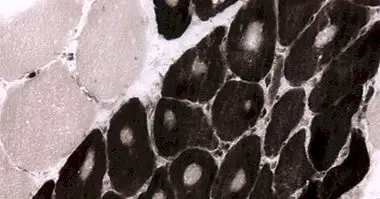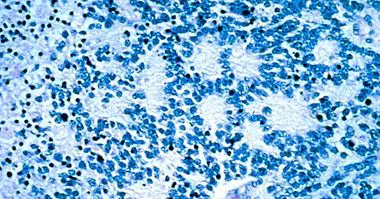Fragile X syndrome: causes, symptoms and treatment
Our genetic code carries the necessary instructions to conform and develop our organism. We inherit much of what we are from our ancestors, although the expression or not on the part of these instructions will depend on the environment in which we live.
However, sometimes there are several genetic mutations that can result in the existence of a disorder in those who carry them. This is the case of fragile X syndrome , the second most frequent cause of mental retardation due to genetic reasons.
- Maybe you're interested: "Intellectual and developmental disability"
Fragile X syndrome: Description and typical symptoms
Fragile X syndrome or Martin-Bell syndrome is a recessive genetic disorder linked to the X chromosome . The symptoms that this syndrome produces can be observed in different areas.
The most noteworthy are those linked to cognition and behavior, although they may present other symptoms such as typical morphological alterations or even metabolic problems. Although it affects both men and women, as a general rule it is much more prevalent in the former, also having a more severe and severe symptomatology.
Cognitive and behavioral symptoms
One of the most characteristic symptoms is the presence of intellectual disability . In fact, along with Down syndrome, fragile X syndrome is one of the most frequent genetic causes of mental retardation. This disability can be highly variable.
In the case of women, an intelligence level located at the limit of intellectual disability is usually observed, with an IQ between 60 and 80. However, in males, the level of disability is usually much higher , with an IQ of generally between 35 and 45. In this case we would be faced with a moderate disability, which would mean a slower and delayed development in the main milestones such as speech, with difficulties in abstraction and the need for a certain level supervision.
Another frequent aspect is the presence of a high level of hyperactivity , presenting motor agitation and impulsive behaviors. In some cases they may become self-injurious. They also present difficulties in concentration and maintenance of attention
It is also possible that they present typically autistic behaviors , which may involve the presence of severe difficulties of social interaction, phobia of contact with other people, mannerisms such as shaking hands and avoidance of eye contact.
- Maybe you're interested: "Types of intelligence tests"
Typical morphology
With regard to physical characteristics, one of the most common morphological characteristics in people suffering from fragile X syndrome is that they have a certain level of macrocephaly since birth , having relatively large and elongated heads. Other usual aspects are the presence of large eyebrows and ears, jaw and prominent forehead.
It is relatively common for them to have hyperlaxal joints, especially in the extremities, as well as hypotonia or muscle tone below what is expected . Spinal deviations are also frequent. Males may also appear macroorchidism, or excessive testicular development, especially after adolescence.
Medical complications
Regardless of the types of characteristics we have seen, people with fragile X syndrome may present alterations such as gastrointestinal problems or reduced visual acuity . Unfortunately many of them present cardiac alterations, having a greater possibility of suffering cardiac murmurs. A high percentage, between 5 and 25%, also suffer seizures or epileptic seizures are localized or generalized.
Despite this, those who have Martin-Bell syndrome can have a good quality of life , especially if the diagnosis is made early and there is a treatment and education that allow the effects of the syndrome to be limited.
Causes of this disorder
As we have indicated, the fragile X syndrome is a disorder of genetic origin linked to the sex chromosome X.
In people suffering from this syndrome the sex chromosome X suffers a type of mutation which causes a specific nucleotide series of the FMR1 gene, specifically the Cytosine-Guanine-Guanine (CGG) chain, to appear excessively repeated throughout the gene.
While subjects without such a mutation may have between 45 and 55 repetitions of said chain, a subject with fragile X syndrome may have 200 to 1300. This prevents the gene from expressing correctly, thus not producing the FMRP protein at be silenced
The fact that the X chromosome is affected by the mutation is the main reason why the disorder is observed more often and with greater severity in men, having only one copy of said chromosome . In women, having two copies of the X chromosome, the effects are minor, and the symptomatology may not even appear (although they may transmit it to the offspring).
Treatment of Martin-Bell syndrome
Fragile X syndrome does not currently have any kind of cure . However, the symptoms caused by this disorder can be treated palliatively and in order to improve their quality of life, through a multidisciplinary approach that includes medical, psychological and educational aspects.
Some of the treatments that are used with people with this syndrome in order to improve their quality of life they are speech therapy and different language therapies in order to improve their communication skills, as well as occupational therapy that helps them to integrate the information of the different sensory modalities.
Programs and treatments of cognitive-behavioral type can be used in order to help them establish basic and more complex behaviors. At the educational level it is necessary that they have individualized plans that take into account their characteristics and difficulties.
At the pharmacological level, SSRIs, anticonvulsants and different anxiolytics are used in order to reduce the symptoms of anxiety, depression, obsessiveness, psychomotor agitation and seizures. Psychostimulant-type drugs are also occasionally used in cases in which there is a low level of activation, as well as atypical antipsychotics in those occasions in which aggressive or self-destructive behaviors usually occur.
Bibliographic references:
- Grau, C .; Fernández, M. & Cuesta, J.M. (2015). Fragile X syndrome: behavioral phenotype and learning difficulties. Century Zero, vol. 46 (4), nº256. Editions University of Salamanca.



















